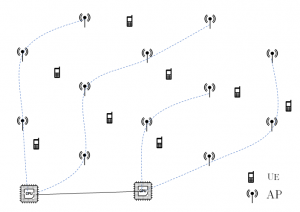The wireless communication community has proposed several different technologies to support increasing service demands from the first (1G) to fifth generation (5G).
One obvious way to increase the network coverage and rate is densification: increasing the number of serving base stations (BSs) or increasing the number of antennas in each BS. In wireless communication terminology, the former approach is called the Ultra-Dense Networks (UDNs) with Small-Cells, and later is known as massive Multiple-Input-Multiple-Output (MIMO).
These two technologies have their own deficiencies: The increased inter-cell interference in UDNs and long distance between BS and final user equipment (UEs) limiting their performance.
To overcome these problems, the Cell-Free massive MIMO (CF-mMIMO) technology has recently been introduced, which combines the good features of the two above technologies to provide better services to the UEs. A simple illustration of CF-mMIMO systems is shown in the following figure, where a large number of distributed Access Points (APs) jointly serves a relatively fewer number of UEs.

Unlike the traditional cellular network, CF-mMIMO systems operate in a user-centric manner: the UEs are in the center and are surrounded and served by multiple APs. The APs are connected to CPUs by high-capacity links, where some network operation and management take place.
CF-mMIMO adopts the block fading models, where time-frequency resources are divided into coherence blocks with t_c channel uses, and each block is composed of three sub-intervals such that: t_c = t_p + t_u + t_d.
- t_p is used for uplink pilot training, where the UEs simultaneously send some unknown signal (pilot) which is used by an AP to estimate its channels between UEs,
- t_u is used for uplink data transmission, where the UEs transmit their own data in this phase,
- t_d is for downlink data transmission, where the UEs receive signals from APs.
The figure below compares the performance of the cell-free massive MIMO systems and cellular networks with small cells located on a grid. As seen, the CF-mMIMO provides a better and uniform service rate for the users in the coverage area, while the small-cell networks, because of the inter-cell interference, experience a high rate drop at the edge of the cells.
The cell-free massive MIMO systems are a relatively new topic in wireless communication and still need to solve many problems before being a daily life technology. Here we are listing some of the challenges CF-mMIMO is facing with:
- Scalability: CF-mMIMO is supposed to serve a huge number of users with hundreds of thousands of antennas. To reach this goal, its system design should be scalable, which means increasing the number of users shouldn’t affect the network performance. Scalability aspects of CF-mMIMO are discussed in [2].
- Synchronization: The network infrastructures need to be synchronized to be able to serve users by a coherent transmission.
- Distributed signal processing: In cell-free systems, most of the networking operations, data detection, precoding, and decoding take place in a central processing unit (CPU). To keep the system scalable, one needs to design an efficient system that distributes the signal processing task on multiple CPUs.
In this opening post we briefly introduced the cell-free massive MIMO systems, and in the next research articles we will elaborate more and discuss some of the issues in CF-mMIMO in detail.
Interested readers can refer to the following resources to find out more about this technology.
The [3] is a great book on the foundations of user-centric cell-free massive MIMO. Also, great surveys on CF-mMIMO can be found in [4, 5, 6].
References
[1] Interdonato, Giovanni, et al. “Ubiquitous cell-free massive MIMO communications.” EURASIP Journal on Wireless Communications and Networking 2019.1 (2019): 1-13.
[2] Björnson, Emil, and Luca Sanguinetti. “Scalable cell-free massive MIMO systems.” IEEE Transactions on Communications 68.7 (2020): 4247-4261.
[3] Demir, Özlem Tuğfe, Emil Björnson, and Luca Sanguinetti. “Foundations of user-centric cell-free massive MIMO.” arXiv preprint arXiv:2108.02541 (2021).
[4] Ammar, Hussein A., et al. “User-centric cell-free massive MIMO networks: A survey of opportunities, challenges and solutions.” IEEE Communications Surveys & Tutorials (2021).
[5] Chen, Shuaifei, et al. “A survey on user-centric cell-free massive MIMO systems.” Digital Communications and Networks (2021).
[6] Elhoushy, Salah, Mohamed Ibrahim, and Walaa Hamouda. “Cell-free massive mimo: A survey.” IEEE Communications Surveys & Tutorials (2021).
